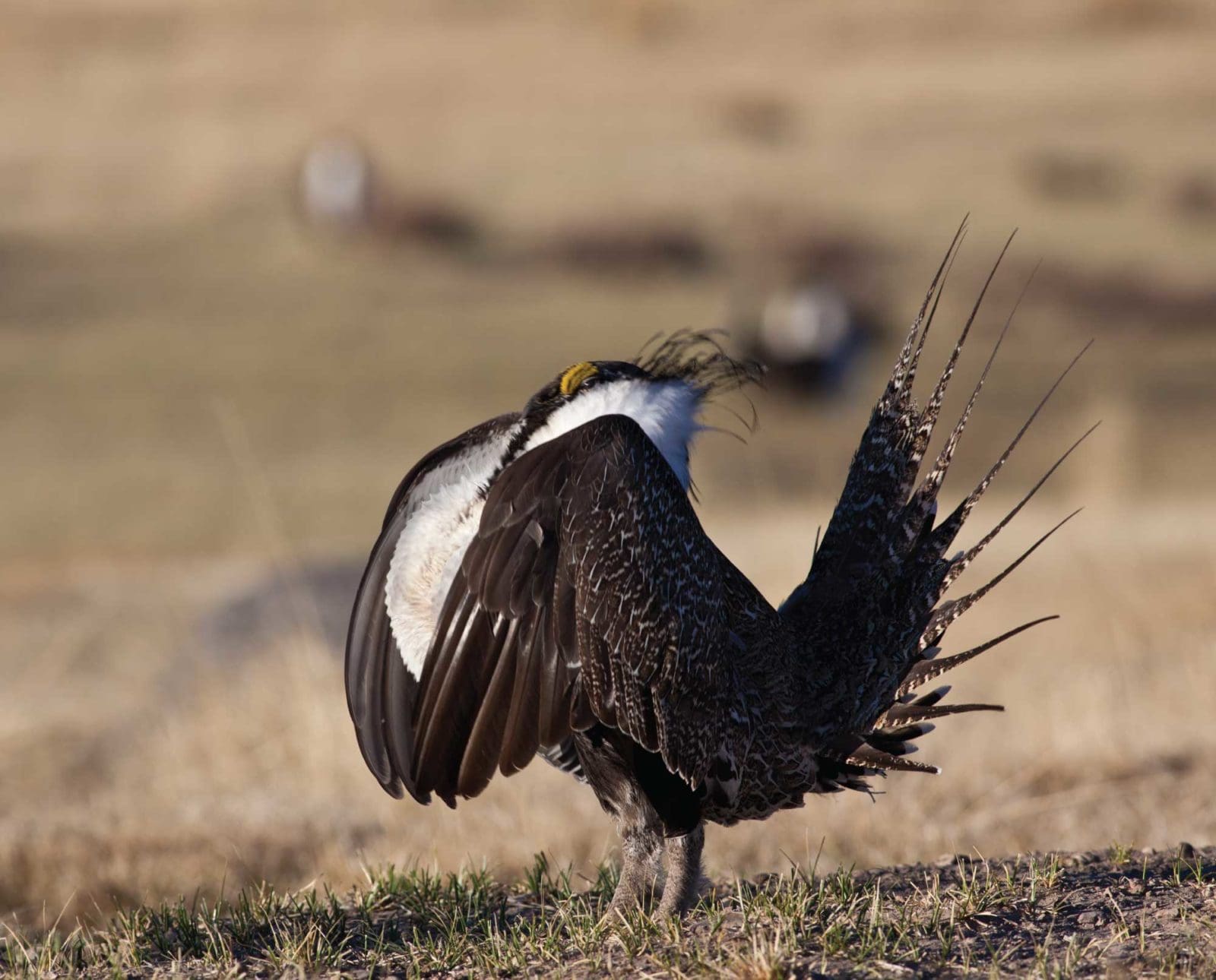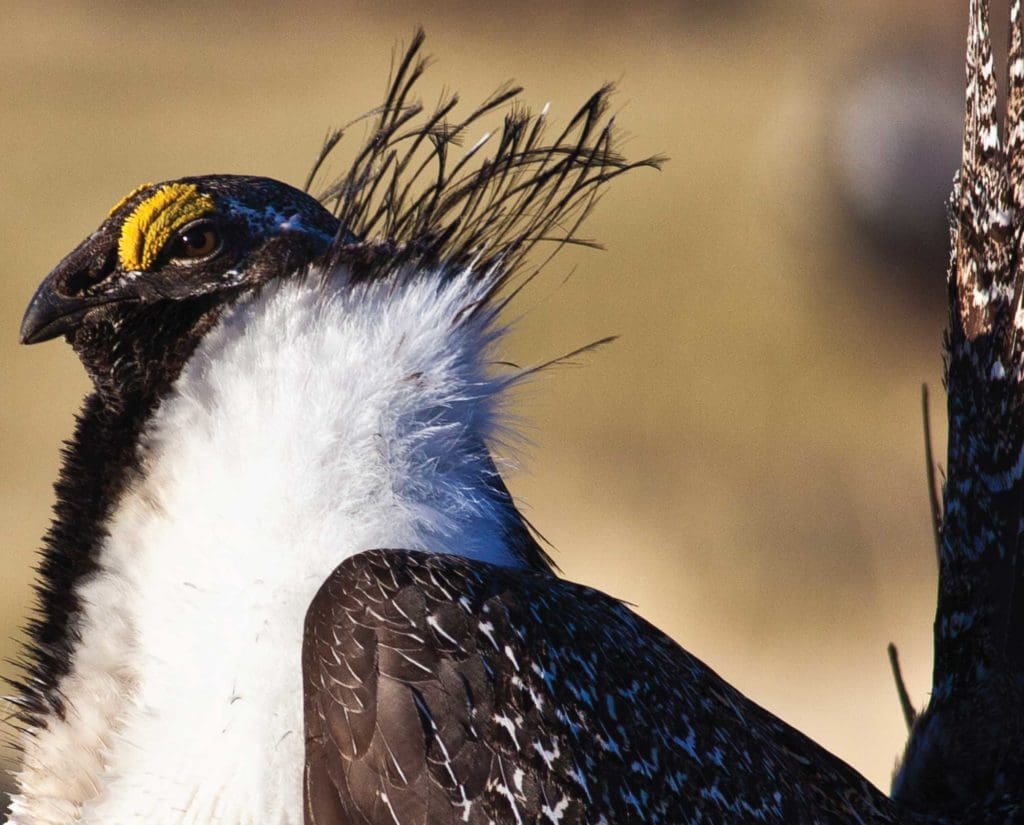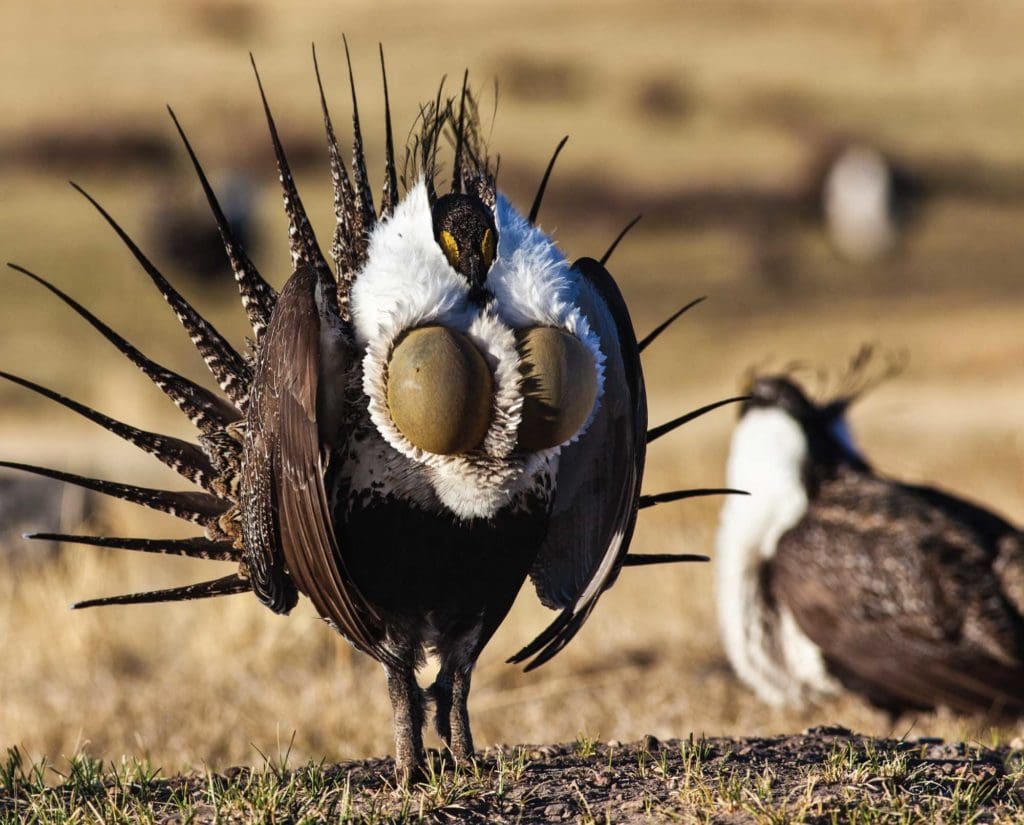Home » Grouse Species » Sage Grouse Hunting » Gunnison Sage-grouse (Centrocercus minimus): A Critically Imperiled Species
Gunnison Sage-grouse (Centrocercus minimus): A Critically Imperiled Species

Gabby Zaldumbide is Project Upland's Editor in Chief. Gabby was…
Prominent filoplumes and limited home ranges define this rare game bird with less than 5000 left in the country.
Most easterners travel west in search of bugling elk, sneaky mule deer, and wandering herds of pronghorn. But these charismatic species aren’t the only wildlife that hunters regularly seek in the sagebrush. Any uplander would admit that they’ve daydreamed about flushing up western grouse, especially sage grouse.
Listen to more articles on Apple | Google | Spotify | Audible
Greater sage-grouse often come to mind when planning upland hunts in at the base of the Rocky Mountains. Their generally stable populations allow them to be hunted, even if bag limits are smaller than other upland bird species living elsewhere. Greater and lesser prairie-chickens are two other species familiar to the average bird hunter. Although greater prairie-chickens are an incredible species to pursue in places like Kansas, unfortunately, lesser prairie-chickens can no longer be hunted. This is due to their increasing conservation needs. In fact, the southern population segment of the lesser prairie-chicken was recently listed as federally endangered. However, there’s one sage grouse species with the greatest conservation needs of all: the Gunnison sage-grouse.
The Gunnison sage-grouse (GUSG) is a critically imperiled sage grouse species most folks aren’t familiar with. Historically, it was lumped in with greater sage-grouse until the 1990s, when biologists began questioning whether or not it should be its own species. It was designated as a new species in the year 2000 by Dr. Jessica Young and her colleagues. Differences in filoplume length, strut rates and vocalizations during lekking season, and genetics were enough to differentiate it from other sage grouse, making it the first new avian species to be described in the United States since the 1800s.
Unfortunately, the GUSG has lost over 90 percent of its habitat and is one of the most at-risk bird species in the United States. Less than 5,000 birds exist today, and that number could be as low as 1,800 individuals. Historically, at least thousands of them existed throughout the southwestern U.S. In Dr. Young’s report from 2000, the authors quoted an article from the Lake City Times from September 13, 1894, that read, “Billy Green, a genial fireman on the 64, bagged 863 sage grouse while out hunting on Sapinero last Sunday.” The research report contrasts this quote with their data from 2014, which recorded just 963 male GUSG globally.
Gunnison Sage-grouse Identification and Life History
The Gunnison sage-grouse looks quite similar to the greater sage grouse; this shouldn’t come as a surprise since wildlife experts themselves didn’t officially tell these species apart until two decades ago. At about two-thirds the size of the greater sage-grouse, Gunnison’s species features long, barred white-and-dark-brown tail feathers that come to a sharp, black point. The males have large white neck ruffs with bright yellow air sacs. They have a matching yellow comb above both eyes and long, decorative filoplume feathers that cascade off the back of their head. Females look generally similar but are less ornate than males. The females don’t have air sacs, neck ruffs, elongated filoplumes, or bright yellow eye combs. Their tail feathers are also shorter than the male’s. However, they both have almost-black belly feathers that begin just below their breast. Both males and females are highly camouflaged when it comes to living in the sagebrush.

Their repetitive calls sound like raspy chicken clucks. Like other upland bird species, the females also make brood contact and assembly calls to their chicks while they raise their young. Both males and females will make a hissing sound at predators.
During the breeding season, grouse assemble at their historic lekking grounds. Leks are typically located on grassy swales, ridgetops, dry lakebeds, and even recently burned areas. Males perform elaborate courtship displays where they arrange themselves into a characteristic “starburst” shape. Their tails fan out, their wing tips drop down, and they flip their filoplumes out in front of their beaks. While doing so, the males fill their vocal sacs with air and drag them through their wings, producing a shushing sound. They also make several sequential coo and popping sounds that impersonate a bubbling creek. The timing of the sounds and dance moves are essential to getting picked by a female prior to mating.
Recent research from the U.S. Geological Survey suggests that ravens are disturbing lekking grouse, flushing them off of their lek sites. Ravens are known to experience population growth in areas where human development is increasing, like the Gunnison basin. Increased disturbances to breeding GUSG can hinder their reproductive success.
Gunnison Sage-grouse Habitat
Only seven populations of Gunnison sage-grouse exist today within southwestern Colorado and eastern Utah. Like their name implies, the GUSG is an obligate of high-elevation sagebrush-steppe ecosystems. It requires large expanses of intact sagebrush to survive. This plant is critical to the grouse’s year-round diet and habitat requirements.
Sagebrush species that are important to GUSG survival include big, black, and low sagebrush. Native forbs, grasses, and other vegetation, including Gambel oak, serviceberry, snowberry, antelope bitterbrush, and rabbitbrush are also part of the sage grouse’s preferred habitat. When female sage grouse raise broods, their young rely on protein-rich food sources like insects to grow. Native wildflowers and other forbs that attract pollinators are incredibly important for growing chicks. Pinyon-juniper encroachment is common in areas where the sage grouse is found, however, the species still frequents areas where this tall, woody vegetation has displaced sage.
Sadly, these plants necessary to the grouse’s survival are being outcompeted by non-native, invasive species like cheatgrass. Sagebrush ecosystems themselves are incredibly vulnerable to human development, too. Grazing has negatively impacted riparian areas over time, and restoring these water-holding areas has been a priority for Gunnison’s wildlife managers for years. In fact, the installation of one rock dams and other structures that replicate nature have effectively restored several wet meadows throughout the valley and beyond.

Gunnison Sage-grouse Conservation Efforts
The Gunnison Sage-grouse Working Group was formed in 1995 to kickstart conservation efforts prior to the federal government recognizing this bird as a new species. This state-level group was a “multi-interested forum representing landowners, sportsmen, land management agencies, the Colorado Division of Wildlife, and the Colorado Cattlemen’s Association,” according to the Land Conservation Assistance Network. However, this Working Group has since evolved into a Strategic Committee. In “The Gunnison Basin Sage-grouse Strategic Committee: A Colorado County’s Fight for Conservation Self-Determination,” James Cochran, Jonathan Houck, and Greg Peterson write in the abstract:
“The early success of a number of these local working groups resulted in sage-grouse conservation plans such as the Gunnison Sage-grouse Conservation Plan, which provides sage-grouse conservation guidance for the Gunnison Basin in South Central Colorado. However, there were problems such as an undefined membership, lack of administrative support, and achieving consensus. The Gunnison County Board of County Commissioners (BoCC) created an entirely new approach to the local work group concept. The Gunnison Basin Sage-grouse Strategic Committee (GBSGSC) was created, with appointed (by the BoCC) representatives from the federal land management agencies, the state wildlife agency, the neighboring county, the ranching community, the environmental community, the development community, the recreation community, and the public at large.”1
“This Committee is created by the Board of County Commissioners to work with the Wildlife Conservation Coordinator to implement programs and steps which will aid in the preservation of the Gunnison Sage-grouse,” states the group’s organizational guidelines.
Despite these early conservation efforts, the grouse was listed as threatened under the Endangered Species Act in 2014. No one wanted to see the grouse earn the title of federally endangered. With private lands making up 43 percent of GUSG habitat and the Bureau of Land Management owning approximately 42 percent, federal, state, and private landowners have been working to conserve the species on their lands ever since. As a result of several decades of hard work, thousands of hours and millions of dollars have been invested in protecting the Gunnison Sage-grouse.
In 2019, the Fish and Wildlife Service released a draft recovery plan for the grouse. The plan was finalized in 2020 after a public comment period. The overall goal of the recovery plan is to establish four resilient populations of Gunnison Sage-grouse. The USFWS will consider these populations to be resilient when “they are sufficiently large to endure stochastic environmental change.”
Wildlife managers plan to meet this goal by using twelve different “recovery actions.” These actionable measures include increasing habitat quality and quantity via weed removal and prevention, conserving existing suitable habitats, translocating and captive-rearing GUSG, and more. The entire list of actions can be reviewed in the USFWS recovery plan. If all goes well, managers expect to delist the grouse in 30 years.
Although most folks have never heard of this elegant game bird, it deserves more attention from conservationists. Dwindling habitat quality and its tiny population will make ensuring the grouse’s conservation success quite tricky, however, I am hopeful. Countless folks care deeply about the restoration of the Gunnison Sage-grouse and are dedicated to protecting the species for years to come.
- Cochran, James; Houck, Jonathan; and Peterson, Greg (2017) “The Gunnison Basin Sage-grouse Strategic Committee: A Colorado County’s Fight for Conservation Self-Determination,” Human–Wildlife Interactions: Vol. 11: Iss. 3, Article 10. DOI: https://doi.org/10.26077/mhmc-xy54. Available at: https://digitalcommons.usu.edu/hwi/vol11/iss3/10
Gabby Zaldumbide is Project Upland's Editor in Chief. Gabby was born in Maryland and raised in southern Wisconsin, where she also studied wildlife ecology at the University of Wisconsin-Madison. In 2018, she moved to Gunnison, Colorado to earn her master's in public land management from Western Colorado University. Gabby still lives there today and shares 11 acres with eight dogs, five horses, and three cats. She herds cows for a local rancher on the side.




Entities and individuals interested in Gunnison Sage-grouse conservation came together in 1995 to form the first Gunnison Sage-grouse working group. Since that time, Federal, State, local governments and private entities have invested millions of dollars and thousands of hours in Gunnison Sage-grouse conservation. Though much of this article is factually correct, to state that conservation efforts only began after the Federal listing of the species is incorrect and misleading.
Thank you for catching this error, James! I will update the article to include information about the working group.
Ravens on the increase? They are hard on grouse in eastern Mt., they showed up in the 80’s. Grazing management has improved through education and good stewardship. Drought has been an issue but I think Ravens need to be managed and are a nasty bird.
Keep ringing the extinction bell for this beautiful bird. The Gunnison is imperiled because of lack of will to stand up to those who also think a few wolves are a problem. These people never want more for anyone but themselves. Mine the evidence for yourself and see what other possible conclusion there is. No wonder someone like Bobert can be elected when backed by such powerful interests. Coupled with all the neglect and oh well attitudes over the years, we are seeing a timeless bird’s total demise, in our lifetime.
Not a good look, Colorado.